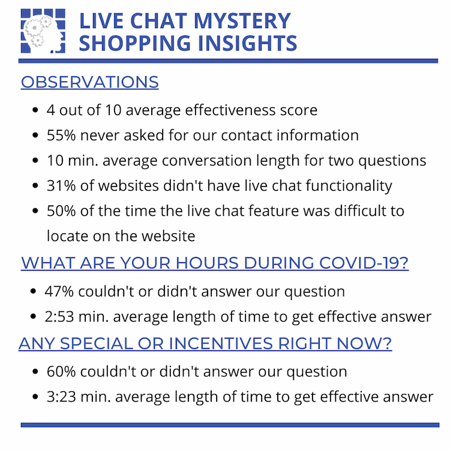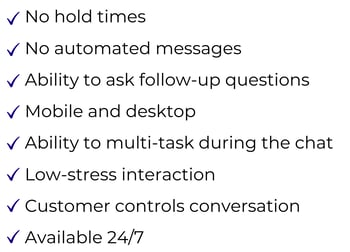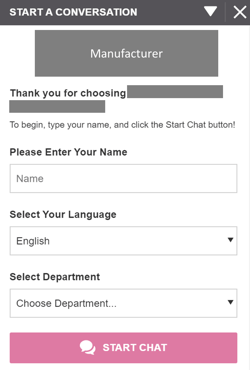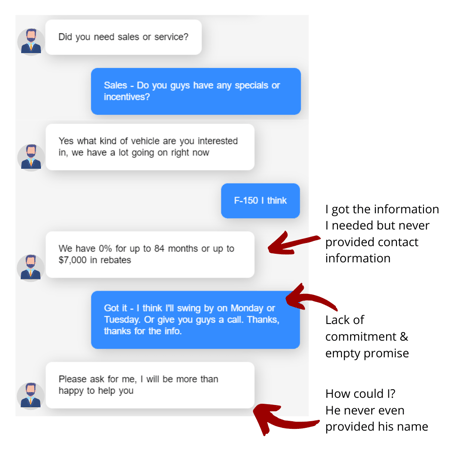Live Chat Best Practices


Live chat on websites is very much en vogue right now — and for good reason. In the age of convenience, where information is available 24/7 and you can get almost anything on-demand, consumers want immediate, transparent answers. If you're able to effectively integrate live chat into your website as well as your sales, marketing and customer success processes, you'll increase customer engagement and fill your pipeline with qualified leads.
Therein lies the challenge. It needs to not only be effectively integrated into your website, it needs to be effectively integrated into 3 different functional areas of your business (sales, marketing, and customer success). This is fraught with complications because installing a live chat function is much easier than integrating it.
This Live Chat Best Practices & Playbook for Car Dealers will help you successfully integrate live chat into your business in a way that meaningfully grows your pipeline through improved customer engagement.
Quick Links
- Mystery Shopping Insights
- Why You Are Using Live Chat Wrong
- Why You Should Embrace Live Chat
- Use Live Chat Effectively
- How We Can Help
Mystery Shopping Insights

The Applied Concepts Insights Team recently mystery shopped over 40 car dealerships' live chat function. We asked two seemingly simple questions: "What are your hours during COVID-19?" And "Do you have any incentives or specials going on right now?"
What we found was interesting and, frankly, disappointing. Without exception, the poor customer experience was a result of poor integration on the dealership's end rather than ineffective software.
The majority of the time, they were unable to answer our questions. And if they were able to answer them, often times the answer was ineffective ("here are the hours, but let me go double check if these are correct during COVID-19") or even contradicted what was on their website.
Why You're Using Live Chat Wrong
Lazy Integration
By far the biggest problem we see with live chat is that it is lazily integrated. It's not enough to simply install the function on your website. You need to invest the time, energy, and money into successfully making live chat an integrated component of your sales, marketing, and customer success processes.
Successful integration is multi-faceted:
Culture - Your team (including your managers) needs to be bought in to providing a customer-centric live chat experience by using your live chat platform.
People - You need enough people to provide effective customer service, clarity around roles, and training to not botch what is likely a customer's first one-on-one interaction with your business.
Technology - Your live chat platform needs to speak to the rest of your sales and marketing platforms.
Procedures - Which employees are going to take these inquiries? How will you handle after-hours inquiries? Will those employees be able to handle inquiries for sales, service, parts, finance, and anything else that may arise? Does your rep have the ability to access your team's calendar to make appointments? How and to whom do you escalate a chat when the question is too complex for the rep? How and when will you transition a chat into an email or phone call? How long is too long for a rep to step away from a chat before sending an update message?
Not a Cure All
The reason for the lazy integration is that companies think it's a plug-and-play approach to deliver fast and improved customer engagement. But it's not unless you commit to an effective integration.
Customers don't care if you respond with "Hi, I'm Sarah, how can I help you today?" in less than 1 nanosecond. And they're not sympathetic to your internal inefficiencies ("Give me a minute, I have to speak with someone in another department for you") or misaligned processes ("I don't have access to the inventory, but I can have someone call you about it"). They just want transparent, honest answers to their questions in a reasonable amount of time.
Exceptional customer service doesn't come pre-packaged with your live chat software. You have to put in the work to build that on top of the software.
[CLICK HERE] for more information on how we can help successfully integrate live chat into your business.
Why You Should Embrace Live Chat
Getting Situated

Live chat platforms come in a couple different shapes and sizes. The most prominent being bot-driven platforms or people-driven platforms. Generally speaking, most platforms are a blend. A consumer's initial inquiry will be handled by an artificial intelligence bot and a representative can take over the conversation when appropriate. This allows a portion of the lead qualification process to be automated.
Put Customers at the Center
In an omni-channel world, your focus should be on increasing engagement in a customer-centric way. Live chat facilitates that by introducing a significant dose of convenience and transparency by putting the customer at the center.
Keep Customers Engaged
The effective use of live chat seamlessly integrates with your website so that customers don't need to leave your website in order to get immediate answers to their questions. It keeps them plugged into your ecosystem, which makes it easier to find up-sell and cross-sell opportunities as well as learn more about your customer through their continued interaction with your website.
Efficiency through Automation
Live chat can have a big impact on your team's efficiency if effectively integrated into your processes. For example, AI bots can respond to a customer's initial inquiry, which will free up more time for your representatives to handle more complex and time-consuming situations. Similarly, by ushering more prospects into the live chat function, you'll be freeing up your team's email inboxes and phone lines, which can be reserved for more complex conversations or customers who are farther along in their buying journey.
Use Live Chat Effectively
Objective of Live Chat
The objective is to advance the ball to the next interaction on a different communication channel (phone, in-person, text, email). You accomplish this by providing correct information rapidly and building a relationship grounded in trust, both of which will encourage them to choose to interact with you again.
Keep in mind, customers asking questions via live chat are likely to be early in their buying journey. It's low stress and almost risk-free. Therefore, the goal is not to close a deal or, necessarily, even set an appointment. It's about making the ask to advance the ball to the next appropriate step.
Tone & Language
Similar to text messaging, when it's a live person chatting, they need to balance being too casual and too stuffy. Avoid too much slang or spelling shortcuts like "u" instead of "you". No one is going to be turned off by proper but conversational language, but many will be turned off by overly casual language. Play it safe by keeping it down the middle.
Similarly, make sure your bot doesn't sound too robotic. While it's true that about 80% of Americans are OK receiving information from a bot (provided that the information is correct and timely), there's a strong preference for "human-sounding" language.
Answer the Question!
If lazy integration is the biggest challenge we see, the refusal (or inability) of the agent to answer the question being asked is the second biggest challenge. Despite its name, no one starts a live chat to actually "chat". They start a live chat because they have a direct question, and your first priority is to answer that question. Don't use live chat simply as a way to collect contact information so that you can have someone call them. That's misaligned with consumer expectations and best practices.
Proper Button Placement
It was surprising how difficult it was to find the live chat feature during Applied Concepts mystery shopping. Although you are free to place your live chat feature anywhere you want on your website, it is becoming accepted practice to put in the bottom right corner of the screen. Customers who are looking for the chat will instinctively look to at the bottom right of their screen, so don't use this as an opportunity to stand out from the crowd.
A Unique Challenge
Unlike the phone or in-person conversations, customers can end the conversation with the click of a button. Once they have the information they need, why stay in the chat even a second longer? This ability to side-step or ignore your questions makes live chat very unique. You need to find a way to keep your customer engaged so that you can use live chat as a relationship-building and pipeline-bolstering tool. Otherwise your live chat will turn into an expensive FAQ page.
Hurdles or No Hurdles?
One of the most controversial topics is whether you should require a customer to submit contact information before beginning a chat. On the one hand, it's generally not advised to ask for something from a customer before giving anything in return and it can place a hurdle in front of a customer before the interaction even begins. On the other hand, contact information is the lifeblood of many retail organizations and can allow you to provide a more customized customer experience.
In a customer-centric world, our view is that you should avoid placing hurdles in front of a customer interaction. That being said, as discussed below, it's crucial to get that contact information early on in the conversation.
Get Contact Information Early
Instead of requiring contact information to initiate a chat, we recommend asking for the contact information early on in the conversation while answering the customer's question.
In our live chat mystery shopping, 55% of dealers never asked of our contact information. Once we had the information we needed, or decided that we'd never get the information because of poor customer service, we closed the chat and moved on. Those chats had a terrible ROI for the dealerships and were a waste of time for the rep speaking with us. But it was realistic, wasn't it? What customer is going to wait around after having their answers so that you can gather their information and dump it into your CRM?
Value in Exchange for Value
The customer knows why you want their contact information—a barrage of follow-ups followed by a consistent drip for the next 3 months that they have limited ability to control or turn-off. The fact is that you get more value from a customer's contact information than a customer gets from giving it to you. That's a problem on a number of different levels.
But you have the ability to exchange value for value. Instead of saying, "What's the best number to reach you?" Consider saying, "What's the best number to text you a virtual walkaround of the vehicle?" You are offering value (video/pictures) in exchange for value (contact information). That's a fair trade.
Your Desire for Information
Don't force it. You need to balance your desire for information with your commitment to offering a customer-centric experience. If you have the ability to re-engage that customer because of their digital interactions (such as advertising re-targeting), then the loss of contact information is less painful.
Be Speedy, but Prioritize Customer Service
The expected response time on live chat is almost instantaneous. You need to capture your customer's attention while it's there for the taking otherwise they'll look for the answers themselves or begin multi-tasking and forget all about their chat. That means you need to respond quickly. But don't let speed stand in the way of customer success.
Get your Staffing Right
Improper staffing is one of the biggest obstacles to effective integration of a live chat feature. It can produce significant delays in response time. If you're going to offer live chat, you need to commit the people necessary to integrate it effectively into your processes. Otherwise don't bother having it at all. You cannot assume your bot will just take care of it.
Hand-Off Between Bot & Human
There may be efficiency reasons why you should use a bot to handle the initial portion of chat, but make sure you have the technology and process in place, including the staffing as well as clear guidelines and responsibilities, to ensure that a human can intervene when appropriate.
Train your Team
Your team requires platform training. Often times there are a multitude of advanced features available to ensure an exceptional customer experience, but your team is incapable of using them to their fullest extent because of poor training and accountability. For example, most live chat platforms provide methods to seamlessly and invisibly transition the conversation from one rep to another rep depending on the nature of the question.
And don't forget to train your team on how to engage with customers on live chat. A lot like text messaging, a lot of managers take for granted that their team has this ability already, and our mystery shopping finds it to be far from the truth.
[CLICK HERE] for more information on how we can help train your team.
Drive Accountability
Develop KPIs that align with your business objectives so that your team clearly understands its goals and your expectations. Popular KPIs include those around response time, chat length, customer satisfaction, and conversion rates.
Consider mystery shopping your live chat with regularity. Applied Concepts can help with this too. We do live chat mystery shopping for customers almost everyday, and they're often shocked by what they uncover.
How We Can Help
Customer demand for live chat is growing everyday, and Applied Concepts is committed to helping you navigate this reality. Contact us at info@appliedconcepts.com or [CLICK HERE] to learn more about how we can help your dealership grow sales.



